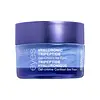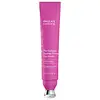What's inside
What's inside
 Key Ingredients
Key Ingredients

 Benefits
Benefits

 Concerns
Concerns

 Ingredients Side-by-side
Ingredients Side-by-side

Water
Skin ConditioningIsododecane
EmollientDimethicone
EmollientGlycerin
HumectantDimethicone Crosspolymer
Emulsion StabilisingPentylene Glycol
Skin ConditioningNeopentyl Glycol Diheptanoate
EmollientPolymethylsilsesquioxane
Myristyl Nicotinate
Skin ConditioningTetrahexyldecyl Ascorbate
AntioxidantButylene Glycol
HumectantCarbomer
Emulsion StabilisingCaprylyl Glycol
EmollientPanthenol
Skin ConditioningCI 77891
Cosmetic ColorantPhenoxyethanol
PreservativeSodium Hydroxide
BufferingHelianthus Annuus Seed Oil
EmollientCitrus Medica Vulgaris Fruit Extract
AntioxidantLens Esculenta Fruit Extract
Skin ConditioningPyrus Malus Fruit Extract
Skin ConditioningNicotiana Benthamiana Octapeptide-30 Sh-Oligopeptide-2
Skin ConditioningParfum
MaskingEthylhexylglycerin
Skin ConditioningHexylene Glycol
EmulsifyingGlyceryl Acrylate/Acrylic Acid Copolymer
HumectantIsohexadecane
EmollientCarnosine
Skin ConditioningDisodium EDTA
Allantoin
Skin ConditioningSodium Hyaluronate
HumectantBenzophenone-4
UV AbsorberSodium Lactate
BufferingGlycine Soja Oil
EmollientAlumina
AbrasiveIsopropyl Titanium Triisostearate
EmollientDunaliella Salina Extract
Skin ConditioningLupinus Albus Seed Extract
Skin ConditioningSodium PCA
HumectantDiglucosyl Gallic Acid
Bacillus/Sea Salt Ferment Filtrate
Skin ConditioningCitric Acid
BufferingEthylene/Propylene/Styrene Copolymer
Lecithin
EmollientSodium Benzoate
MaskingPolyhydroxystearic Acid
EmulsifyingPotassium Sorbate
PreservativeOryza Sativa Extract
AbsorbentBenzyl Benzoate
AntimicrobialPolyglyceryl-3 Diisostearate
EmulsifyingLimonene
PerfumingPalmitoyl Tripeptide-5
Skin ConditioningPantolactone
HumectantButylene/Ethylene/Styrene Copolymer
Silica
AbrasiveGlobularia Alypum Leaf Extract
Skin ConditioningLinalool
PerfumingPlankton Extract
Skin ConditioningCitral
PerfumingCitronellol
PerfumingTocopherol
AntioxidantGeraniol
PerfumingBenzyl Salicylate
PerfumingBenzyl Alcohol
PerfumingCI 42090
Cosmetic ColorantWater, Isododecane, Dimethicone, Glycerin, Dimethicone Crosspolymer, Pentylene Glycol, Neopentyl Glycol Diheptanoate, Polymethylsilsesquioxane, Myristyl Nicotinate, Tetrahexyldecyl Ascorbate, Butylene Glycol, Carbomer, Caprylyl Glycol, Panthenol, CI 77891, Phenoxyethanol, Sodium Hydroxide, Helianthus Annuus Seed Oil, Citrus Medica Vulgaris Fruit Extract, Lens Esculenta Fruit Extract, Pyrus Malus Fruit Extract, Nicotiana Benthamiana Octapeptide-30 Sh-Oligopeptide-2, Parfum, Ethylhexylglycerin, Hexylene Glycol, Glyceryl Acrylate/Acrylic Acid Copolymer, Isohexadecane, Carnosine, Disodium EDTA, Allantoin, Sodium Hyaluronate, Benzophenone-4, Sodium Lactate, Glycine Soja Oil, Alumina, Isopropyl Titanium Triisostearate, Dunaliella Salina Extract, Lupinus Albus Seed Extract, Sodium PCA, Diglucosyl Gallic Acid, Bacillus/Sea Salt Ferment Filtrate, Citric Acid, Ethylene/Propylene/Styrene Copolymer, Lecithin, Sodium Benzoate, Polyhydroxystearic Acid, Potassium Sorbate, Oryza Sativa Extract, Benzyl Benzoate, Polyglyceryl-3 Diisostearate, Limonene, Palmitoyl Tripeptide-5, Pantolactone, Butylene/Ethylene/Styrene Copolymer, Silica, Globularia Alypum Leaf Extract, Linalool, Plankton Extract, Citral, Citronellol, Tocopherol, Geraniol, Benzyl Salicylate, Benzyl Alcohol, CI 42090
Water
Skin ConditioningDimethicone
EmollientPentylene Glycol
Skin ConditioningSilica
AbrasiveSqualane
EmollientUndecane
EmollientGlycerin
HumectantPyrus Malus Fruit Extract
Skin ConditioningTridecane
Perfuming1,2-Hexanediol
Skin ConditioningAmmonium Acryloyldimethyltaurate/Vp Copolymer
Cetyl Alcohol
EmollientPolyglyceryl-10 Laurate
Skin ConditioningPolyglyceryl-4 Caprate
EmulsifyingHydroxyacetophenone
AntioxidantPropanediol
SolventTridecapeptide-1
Skin ConditioningPalmitoyl Tetrapeptide-7
Skin ConditioningAcetyl Hexapeptide-8
HumectantArginine/Lysine Polypeptide
Skin ConditioningAcrylates/C10-30 Alkyl Acrylate Crosspolymer
Emulsion StabilisingSodium Phytate
Sorbitan Oleate
EmulsifyingDiosmine
AntioxidantColeus Forskohlii Root Extract
EmollientCaprylyl Glycol
EmollientXanthan Gum
EmulsifyingGlyceryl Caprylate
EmollientPseudoalteromonas Ferment Extract
HumectantTocopherol
AntioxidantWater, Dimethicone, Pentylene Glycol, Silica, Squalane, Undecane, Glycerin, Pyrus Malus Fruit Extract, Tridecane, 1,2-Hexanediol, Ammonium Acryloyldimethyltaurate/Vp Copolymer, Cetyl Alcohol, Polyglyceryl-10 Laurate, Polyglyceryl-4 Caprate, Hydroxyacetophenone, Propanediol, Tridecapeptide-1, Palmitoyl Tetrapeptide-7, Acetyl Hexapeptide-8, Arginine/Lysine Polypeptide, Acrylates/C10-30 Alkyl Acrylate Crosspolymer, Sodium Phytate, Sorbitan Oleate, Diosmine, Coleus Forskohlii Root Extract, Caprylyl Glycol, Xanthan Gum, Glyceryl Caprylate, Pseudoalteromonas Ferment Extract, Tocopherol
Ingredients Explained
These ingredients are found in both products.
Ingredients higher up in an ingredient list are typically present in a larger amount.
Caprylyl Glycol is a humectant and emollient, meaning it attracts and preserves moisture.
It is a common ingredient in many products, especially those designed to hydrate skin. The primary benefits are retaining moisture, skin softening, and promoting a healthy skin barrier.
Though Caprylyl Glycol is an alcohol derived from fatty acids, it is not the kind that can dry out skin.
This ingredient is also used as a preservative to extend the life of products. It has slight antimicrobial properties.
Learn more about Caprylyl GlycolDimethicone is a type of synthetic silicone created from natural materials such as quartz.
What it does:
Dimethicone comes in different viscosities:
Depending on the viscosity, dimethicone has different properties.
Ingredients lists don't always show which type is used, so we recommend reaching out to the brand if you have questions about the viscosity.
This ingredient is unlikely to cause irritation because it does not get absorbed into skin. However, people with silicone allergies should be careful about using this ingredient.
Note: Dimethicone may contribute to pilling. This is because it is not oil or water soluble, so pilling may occur when layered with products. When mixed with heavy oils in a formula, the outcome is also quite greasy.
Learn more about DimethiconeGlycerin is already naturally found in your skin. It helps moisturize and protect your skin.
A study from 2016 found glycerin to be more effective as a humectant than AHAs and hyaluronic acid.
As a humectant, it helps the skin stay hydrated by pulling moisture to your skin. The low molecular weight of glycerin allows it to pull moisture into the deeper layers of your skin.
Hydrated skin improves your skin barrier; Your skin barrier helps protect against irritants and bacteria.
Glycerin has also been found to have antimicrobial and antiviral properties. Due to these properties, glycerin is often used in wound and burn treatments.
In cosmetics, glycerin is usually derived from plants such as soybean or palm. However, it can also be sourced from animals, such as tallow or animal fat.
This ingredient is organic, colorless, odorless, and non-toxic.
Glycerin is the name for this ingredient in American English. British English uses Glycerol/Glycerine.
Learn more about GlycerinPentylene glycol is typically used within a product to thicken it. It also adds a smooth, soft, and moisturizing feel to the product. It is naturally found in plants such as sugar beets.
The hydrophilic trait of Pentylene Glycol makes it a humectant. As a humectant, Pentylene Glycol helps draw moisture from the air to your skin. This can help keep your skin hydrated.
This property also makes Pentylene Glycol a great texture enhancer. It can also help thicken or stabilize a product.
Pentylene Glycol also acts as a mild preservative and helps to keep a product microbe-free.
Some people may experience mild eye and skin irritation from Pentylene Glycol. We always recommend speaking with a professional about using this ingredient in your routine.
Pentylene Glycol has a low molecular weight and is part of the 1,2-glycol family.
Learn more about Pentylene GlycolPyrus Malus Fruit Extract is extract from Apples. Apples are rich in Vitamin C, sugars, and antioxidants.
The sugar in Apples are humectants and help hydrate the skin. On top of that, apples also contain some acids, such as malic acid. These acids may have a mild exfoliating effect.
Last, the phytochemicals found in apples are strong antioxidants. These antioxidants help with anti-aging as they protect your skin cells against oxidative damage.
Learn more about Pyrus Malus Fruit ExtractSilica, also known as silicon dioxide, is a naturally occurring mineral. It is used as a fine, spherical, and porous powder in cosmetics.
Though it has exfoliant properties, the function of silica varies depending on the product.
The unique structure of silica enhances the spreadability and adds smoothness, making it a great texture enhancer.
It is also used as an active carrier, emulsifier, and mattifier due to its ability to absorb excess oil.
In some products, tiny microneedles called spicules are made from silica or hydrolyzed sponge. When you rub them in, they lightly polish away dead skin layers and enhance the penetration of active ingredients.
Learn more about SilicaTocopherol (also known as Vitamin E) is a common antioxidant used to help protect the skin from free-radicals and strengthen the skin barrier. It's also fat soluble - this means our skin is great at absorbing it.
Vitamin E also helps keep your natural skin lipids healthy. Your lipid skin barrier naturally consists of lipids, ceramides, and fatty acids. Vitamin E offers extra protection for your skin’s lipid barrier, keeping your skin healthy and nourished.
Another benefit is a bit of UV protection. Vitamin E helps reduce the damage caused by UVB rays. (It should not replace your sunscreen). Combining it with Vitamin C can decrease sunburned cells and hyperpigmentation after UV exposure.
You might have noticed Vitamin E + C often paired together. This is because it is great at stabilizing Vitamin C. Using the two together helps increase the effectiveness of both ingredients.
There are often claims that Vitamin E can reduce/prevent scarring, but these claims haven't been confirmed by scientific research.
Learn more about TocopherolWater. It's the most common cosmetic ingredient of all. You'll usually see it at the top of ingredient lists, meaning that it makes up the largest part of the product.
So why is it so popular? Water most often acts as a solvent - this means that it helps dissolve other ingredients into the formulation.
You'll also recognize water as that liquid we all need to stay alive. If you see this, drink a glass of water. Stay hydrated!
Learn more about Water